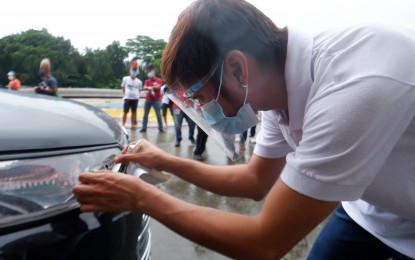
MANILA – Motorists hoping to drive through all toll expressways in Luzon beginning Dec. 1 will need two separate radio-frequency identification (RFID) tags, according to the Toll Regulatory Board (TRB).
In a statement on Thursday night, the TRB said it would not delay the mandatory use of cashless transactions in toll expressways beyond the new deadline, noting that it would not wait for the interoperability of the country’s two tollways RFID systems.
“Any delay in its implementation amid the Covid-19 pandemic will only make motorists, as well as the personnel manning the toll plazas, vulnerable to unwanted and unnecessary physical contact, and hence, exposure to the deadly coronavirus,” the TRB said.
Both RFID tags, it said, are free of charge aside from its load that will need to be purchased separately by motorists.
“There is no real or added financial burden for motorists. Having both RFIDs is also not confusing since the physical appearance of the tags are contrastingly different,” the TRB said.
Once interoperability is implemented, there is no “potential burden or loss” for motorists who already have both RFID tags since the load of existing tags may be transferred to a new RFID or used until consumed.
“As for the issue of limited RFID installation sites, the solution is not to defer the cashless program, but for toll operators to increase the number of installation booths and manpower in strategic places,” the TRB said.
The mandatory use of cashless transactions in toll expressways, it said, is the first of three phases of the Toll Interoperability Project (TIP).
“The project’s second phase involves the use of two RFID wallets, which will make a single RFID sticker readable by sensors at different toll roads. Each wallet will contain the load for payments at specific toll plazas,” the TRB said.
The third phase, it said, will allow the use of one RFID sticker with one load wallet for all toll expressways.
In a radio interview on Thursday, DOTr Secretary Arthur Tugade said the second phase of the TIP may be rolled out by mid-2021.
“Nagsusumamo at nakikiusap ako sa ating mga kababayan, may mga birth pains diyan.’Yung mga ideal situation o ideal na estado, makakamtan natin sa darating na panahon (I’m asking our fellow Filipinos to understand that there will be birth pains for this new project. We will have a more ideal situation in the future),” Tugade said.
The country’s expressways currently have two different operators, the San Miguel Corporation (SMC)—which uses the AutoSweep RFID—and the Metro Pacific Tollways Corporation—which uses the EasyTrip RFID.
The SMC currently operates the South Luzon Expressway, Southern Tagalog Arterial Road Tollway, the Skyway, Tarlac Pangasinan La Union Expressway, the Muntinlupa Cavite Expressway, and the Ninoy Aquino International Airport Expressway.
Meanwhile, the MPTC operates the North Luzon Expressway, NLEX Harbor Link, Subic Clark Tarlac Expressway, Cavite Laguna Expressway, C5 Link, and the Cavite Expressway.